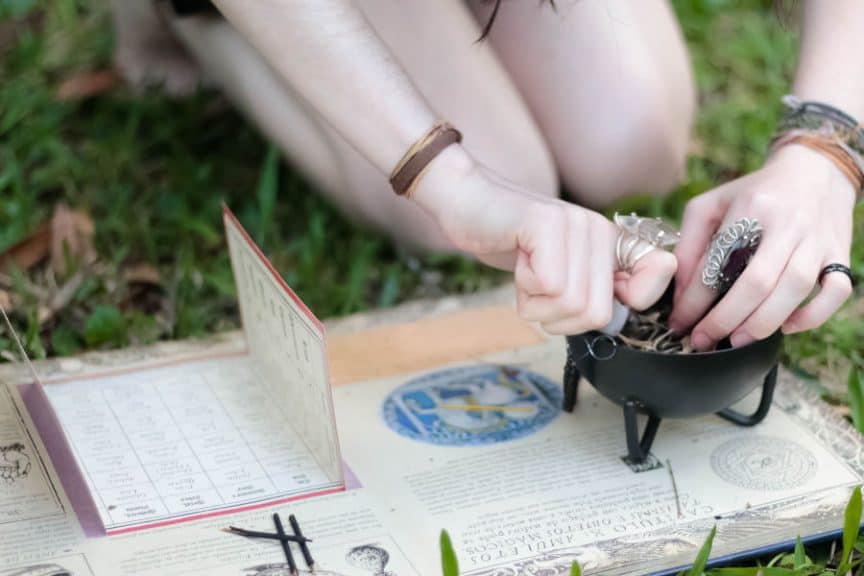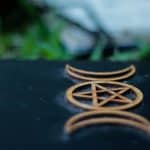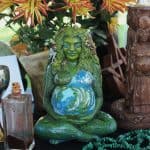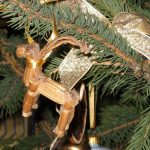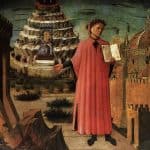Have you ever heard of Wiccan Holidays or the Sabbats? If not, then you will be forgiven…After all, isn’t there such a flurry of holidays nowadays it’s hard to keep tabs?
It’s no secret that we all love to celebrate holidays, so much so that in a calendar year, there are tons of holidays included. Typically, the most common ones include Christmas, New Year, Labor Day, and several others either affiliated with religion or established by the government to commemorate major events in a nation.
Nonetheless, there are some other less popular ancient holidays, which nevertheless hold significant importance to various groups of individuals, and one such is the Wiccan Holidays.
So what exactly are Wiccan Holidays and what are they all about?
Wiccan holidays or Sabbats are festivities commemorated by the pagan religion. These holidays celebrate the journey of the sun around the globe, known as the Wheel of the Year, with Wiccans referring to the celebration of these holidays as the “turning of the wheel.”
As this wheel turns, several milestones are accomplished. Every moment is dedicated to assembling with family and colleagues, refining spiritual growth, as well as merrymaking and feasting!
Wiccan holidays comprise four traditional and four astronomical festivals in between. In unison, it is these eight holidays that are called the “Wheel of the Year.” These holidays are significant to both Wiccan as well as Wicca-allied neo-Paganism movements.
Related reading: Most Commonly Practiced Branches of Wicca – Opens in new tab
Here is everything you need to know about these major Wiccan Holidays:
What is the Wheel of the Year, and what is it all about?
In simple terms, the “Wheel of The Year” represents the eight Wiccan holidays or Sabbats. In essence, these holidays are aimed at celebrating and honoring the cycles and seasons of life for individuals who practice Wicca or Paganism.
Even persons not affiliated with these beliefs, or spiritual denominations identify these holidays in varying ways. Usually, the Sabbats or Wiccan holidays are evenly split across the year and represent both the beginning of and mid-way points between every season.
They are known as “pagan holidays” since they are based on the unique Germanic and Celtic pagan religions. Typically, the Wiccans observe these special days as “Sabbats.”
While the term “Sabbat” can initially be traced in Hebrew and Judaism, when it comes to the particular Wiccan religion, the term originates from another term “Sabbath” which means a gathering or meeting to practice rites and rituals.
Wiccan holiday, Sabbat, and Pagan holiday are all interchangeable since they all represent similar days where celebrations and rituals occur.
Do you want to learn more about Wicca and Witchcraft? Check out our recommendations at “Wiccan Bookshelf”
Origins of the Wiccan Holidays / Sabbats
The source of the Wiccan holidays can be primarily traced back to Germanic and Celtic pagan rituals, numerous moons back. Both Germanic and Celtic pagans celebrated several of the holidays.
Nonetheless, what is uncertain is precisely when the eight holidays were combined to form the now recognized and accepted “Wheel of the Year.”
Wiccan holidays of Celtic origin include:
- Samhain
- Imbolc
- Lughnasa
- Beltane
Wiccan holidays of Germanic origin include:
- Mabon
- Yule
- Litha
- Ostara
For a better understanding of the origin of Wicca read our article: Comprehensive Guide To Wiccan Origins And Beliefs
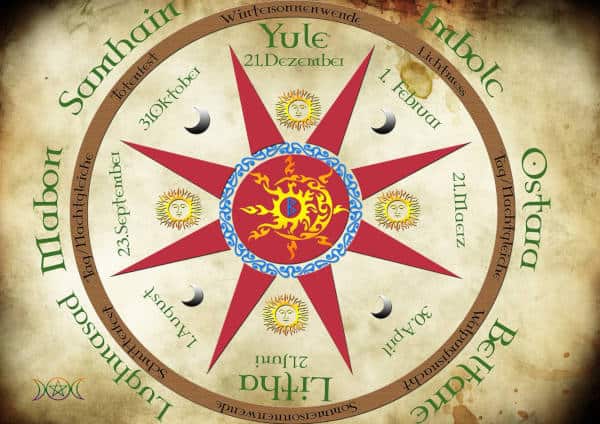
Usually, the Sabbats or Wiccan holidays are however not split relative to either origin but are categorized in different classifications as outlined below:
1. Lesser and Greater Sabbats
As per the distinct Wiccan beliefs, the Wiccan holidays are divided into ‘Lesser’ and ‘Greater Sabbats.’ Usually, Lesser Sabbats represent the sabbats that either fall on the equinoxes or solstices. They are also called quarter holidays since they evenly split a year per the position of the sun. Lesser Sabbats are primarily of Germanic pagan origin and include Mabon, Yule, Litha, and Ostara.
Alternatively, Greater Sabbats represent those that occur between cross-quarter days. They are also called Fire Festivals and are of Gaelic or Celtic pagan origin. They include Samhain, Beltane, Lughnasa, and Imbolc.
2. Sun and Moon Sabbats
Wiccan holidays are also classified into Moon and Sun Sabbats. Typically, Sun holidays represent the sabbats which are determined on where the sun is positioned usually between the Sun either falling on Equinox or Solstice. These sabbats include Ostara, Mabon, Litha, and Yule.
The Moon Wiccan holidays are commemorated during full moons, except Samhain which is celebrated during the dark moon. They include Samhain, Beltane, Imbolc, and Lughnasa.
Courtesy of this precise classification of two (four Sabbats) sets, there is a unique blend that has become the eight main Wiccan holidays known today. Both the sun’s astronomical positioning, particularly during the equinoxes and solstices, as well as the seasons obviously happen globally, meaning that similar celebrations can effectively be done across the globe.
Do you want to learn more about Wicca and Witchcraft? Check out our recommendations at “Wiccan Bookshelf”
Table of Wiccan & Pagan Holidays (Sabbats)
| Sabbat | When | Keywords | Symbols | Category | Colors | Spells |
|---|---|---|---|---|---|---|
| Yule | 20th-23rd December | Winter Solstice, Rebirth, The Return of the Sun | Bonfires, Evergreens, Mistletoe, Wreaths, Bells, Candles, Elves | Lesser / Sun | Red, Green, White, Silver, Gold | Love, Harmony, Happiness, Peace, Fertility |
| Imbolc | 1st or 2nd February | The Goddess, New Beginnings | Plows, Candle Wheels, Brigid Crosses, White Flowers, Brigid Doll, Snowdrops, Sheep and Milk, Blackberry, The Serpent, The Triple Goddess | Greater / Moon | White, Silver, Green | Cleansing, Purifying, Scrying, Lithomancy, Love Spells |
| Ostara | 19th and 22nd March | New Beginnings, Spring Equinox, Hope, Abundance | Butterflies, Shamrock, Eggs, Seeds, Bunnies, Serpents, Dragons, Spring Flowers | Lesser / Sun | Green, Light blue, Pink, White, Yellow | Blessing, Fertility, Life, Birth, Rebirth |
| Beltane | 30th April’s evening to 1st of May | Togetherness, Fertility, Arrival Of Spring, Promise Of Summer | Maypole, Horns, Acorns, Seeds, Cauldron, Swords, May Baskets | Greater / Moon | Green, Yellow, Purple, Blue | Fertility, Sexuality |
| Litha | 20th and 22nd June | Midsummer, Summer Solstice, The Longest Day of the Year | Sun Wheel, Sun, Fire, Bonfires, Oak, Roses, Daisies, Flowers, Torches, Fairies | Lesser / Sun | White, Red, Yellow, Orange, Gold, Green | Divination, Creativity, Inspiration, Love, Healing, Fertility, Happiness, Health, Love & Relationships |
| Lammas | 31st July or 1st August | The First Harvest, Gathering, Abundance | Grains, Corn, Apples, Flowers, Leaves and Herbs, Bread, Spears, Grapes, Wine | Greater / Moon | Yellow, Gold, Orange, Brown, Green, Red | Abundance, Protection |
| Mabon | 21st September and 23rd September | Autumn Equinox, Balance, The Second Harvest, Thanksgiving, Gratitude | Acorns, Grapes, Wine, Gourds, Fallen Leaves, The Cornucopia, Dried Seeds, Eggplant, Pumpkin | Lesser / Sun | Green, Red, Orange, Yellow, Brown, Gold, Bronze | Balance, Harmony, Confidence, Prosperity, Reflection |
| Samhain | 31st October | The Beginning of Winter, Halloween, Thinned Veil Between the Worlds, Otherworld, Souls of Dead, End of The Harvest | Bowen Knot, Black Cats, Candles, Acorns, Apples, Pumpkin, Cauldron, Besom Broom, Skulls, Bat, Ghost, Scarecrow, Waning Moon | Greater / Moon | Orange, Purple, Black | Candle Magick, Divination, Inner Work, Protective, Cleansing, Reflection, Protection |
The Eight Main Wiccan Holidays / Sabbats
For modern Wiccans and Pagans, everything is regarded as reoccurring and cyclical hence the association and imagery of the wheel.
Typically, these festivals effectively follow the sun’s “life” and “death” each year, with the holidays also in accordance with this. These eight celebrations signify the most prevalent times for seasonal celebrations.
1. Yule
Also known as “Midwinter” or Winter Solstice is identified as either the start or end of a year, as per the distinct yearly cycle. Yule which falls at around 20th-23rd December symbolizes the light and the sun’s return, as well as the Horned God’s rebirth, the latter being the solstice sun’s newborn.
Yule is also quite astrologically significant since it is the longest night and shortest day of the year.
Several of Yule’s sacred plants include ivy, evergreen, and holly; while herbs linked with Yule include myrrh, star anise, coriander, mistletoe, pomegranate, frankincense, spikenard, apple, cinnamon, clove, and oak.
How is it celebrated? Generally, a celebration/festival is held on a precise day. It can usually be celebrated by burning sun candles to not only welcome the sun but also represent it in spells and rituals.
Persons can also decorate altars with seasonal herbs and plants (as outlined above) or even cast out spells. Some of the spells that can be cast in Yule include spells associated with love, harmony, enhancing happiness, and peace.
Learn more about Yule: Yule -The Pagan Celebration of Winter Solstice That Inspired Modern Christmas – Opens in New tab.
2. Imbolc
Also usually known as Brigid’s Day, Imbolc is a Wiccan holiday that celebrates the promise of Spring. Generally occurring between 1st or 2nd February, this holiday commemorates pure joy. It is usually the time during the year to celebrate possibility, emerging life, as well as new growth surrounding us.
The symbols that signify Imbolic include plows, candle wheels, Brigid Crosses, and white flowers. Moreover, there are several sacred herbs and plants for this occasion, including bay, iris, basil, wisteria, coltsfoot, and blackberry.
Also, there are several images associated with this Sabbat, including the crown of light, the Goddess and the God’s reunion, as well as various ceremonies and celebrations surrounding fertility and new life.
How is it celebrated? This sabbatic can usually be commemorated in numerous different ways. You can participate in ritual candle lighting where witches light candles in every room of a house just after sunset as a way of honoring the rebirth of the sun.
Furthermore, Imbolc also means time to not only feast but also regroup to laugh, reflect, and even share. Finally, this sabbatic represents an ideal time for casting cleansing spells as well as purifying your energy in preparation for spring.
Learn more about Imbolc: Imbolc – The Festival of Brigid that Marks the Beginning of Spring– Opens in New tab.
3. Ostara
Also known as the Spring Equinox or Vernal, this holiday falls between 19th and 22nd March. It signifies spring’s official arrival. Ostara is usually the second event of the three fertility celebrations, and it is at this time that spring blessings become more apparent to the natural earth. The event is signified by eggs and the hare.
This festival is represented by the Maiden Goddess and Sun God, the former who conceives and is set to be a Great Mother 9 months later. Various flowers such as lilies, daffodils, violets, and peonies are among the common Spring Equinox symbols. Herbs linked with this holiday include rose or jasmine. Usually, things are brighter, more feminine, and more joyous during this sabbat.
How is it celebrated? Being an Equinox (a day among the two days in a year where night and day are approximately equivalent), it basically represents balance. At this time, you can set intentions, as well as appreciate nature and the spring. It is also a magical day that promises new beginnings and promises. You can celebrate it by planting seeds, as well as blessing plants and subsequently scattering them across the home or altar, or even casting various balancing and spring spells.
Learn more about Ostara: Ostara – The Pagan Celebration of the Spring Equinox– Opens in New tab.
Check out our free resources at “Free Library“
4. Beltane
Also called May Day, Beltane is usually celebrated from the 30th April’s evening to the 1st of May. It signifies the midway point between summer and spring. Initially, this holiday was a distinct fire festival and was primarily celebrated in pre-Christian Scotland and Ireland. Its name comes from the name Bel, a renowned god, and means “bright one”.
It simply defines “Bel’s Fire.” Together with Samhain, they are the two primary festivals outlined on Celtic Pagan’s calendar, and they are both the two main poles of the distinct magickal year, mainly where the spirit realm and gates to Faery are mostly open to travelers.
In the Celtic traditions, May Day represented a time when unashamed sexuality and promiscuity were highly encouraged, although this does not necessarily apply this way today.
Since this sabbat is labeled, a Feast of Fire, one of the largest represented symbols signifying this holiday is fire. Colors signifying Beltane include red, green, white, and silver, and this holiday is celebrated with rosemary, cinnamon, apples, and gingerbread.
How is it celebrated? While it was traditionally associated with festivity and unbridled sensuality, this is rare today. Nonetheless, when invited to rituals during this celebration, you will probably dance around a distinct maypole or subsequently witness an emblematic Great Rite (featuring an athame and a chalice) as opposed to encountering orgies.
Moreover, Beltane is best celebrated with bonfires; hence, you need to get to places with ceremonial fires.
You can also cast spells that involve fertility, union, alignment of feminine and masculine energies within yourself, as well as sharing intimacy. You can also perform spells and purification for encouraging vitality.
Finally, since this holiday commemorated the Goddess and the God’s union, it is an ideal time for handfastings, proposals, and vow renewals.
Learn more about Beltane: Beltane ‘Fires of Bel’ – The Celtic “May Day” festival at the beginning of Summer– Opens in New tab.
5. Litha
This marks the longest day in the entire year and officially signifies summer entrance. It generally falls between the 20th and 22nd of June. At this period, the principal Sun God is often at his power peak; and is a unique day controlled by both the element of fire as well as the Sun.
During this period, there is ample time in the course of the day for working as well as some light to commemorate also. Generally regarded as the handfasting or coupling festive season, it is in the month of June when numerous unions and marriages are created and effectively celebrated also. This period is abundant with joy and blessing.
The Sun God, otherwise also known as the Lord of green, oak, and emerald elements as well as of the Forest represents this festival. The commonly used herbs in this holiday are honeysuckle, mugwort, and lemon, chamomile, among others which can be divided into portions, burned as incense around your home, or used in adorning an altar.
How is it celebrated? Since this period is primarily about light and the sun, the celebrations are primarily centered on relatively longer days as well as the Sun’s remarkable power.
This time is ideal for reaffirming your vows as well as practicing them, thanking for all the blessings, as well as establishing a connection with nature/earth. After this sabbat, the nights start growing longer while the Sun subsequently shifts further with every single day going.
Also common during Litha are outdoor rituals since pagans exploit the longer daylight hours. The ceremonies may include meditation, and meeting with groups or covens for celebration, outside where the sun is shining.
Summer games and bonfires are also common events that mark this period. Finally, Litha presents a great time for protection, truth, charisma, and cleansing spells.
Learn more about Litha: “Litha – The Midsummer Sabbat to Celebrate the Power of the Sun”– Opens in New tab.
6. Lammas / Lughnasadh
August Eve is a Wiccan holiday and is usually celebrated both the awareness of summer ending and first harvests. Being one of the three distinct autumnal harvest celebrations, it occurs on either the 31st of July or the 1st of August.
It basically represents a thanksgiving time to the Goddess and God for the seeds, crops, food to eat, as well as guarantee the occurrence of new harvest in the future. Basically, it signifies a celebration of the life cycle as well as what we own.
This sabbat is related to anything that is fall, including grains, corn, vibrant colors such as gold and red, apples, among many others. Usually, altars may be adorned with herbs or wheat, including heather, sandalwood, or even small fruit baskets.
How is it celebrated? Basically, celebrating this holiday is mainly about thanksgiving as well as being grateful. It is a distinct time for welcoming harvest. Grain is often the traditional food during this time and is usually presented in the form of barley, ales, beers, and wheat.
For Celtic Pagans, this event symbolized the agricultural god’s (Lugh) feast although he is also a musician, poets, and craftspeople patron.
Here, you can show off any skills you have learned and subsequently trade them to get essential items. It represents a traditional year time for local markets and craft fairs.
Learn more about Lammas: Lammas (Lughnasadh) – the Pagan Festival for the First Harvest – Opens in New tab.
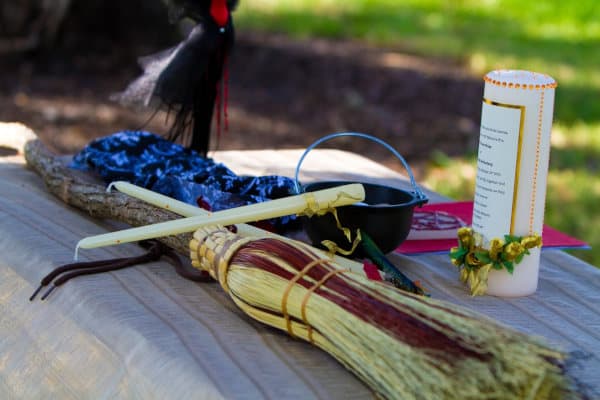
7. Mabon
Also known as the Autumnal Equinox, this holiday falls between 21st September and 23rd September. It is also called 2nd Harvest since it is at a time when nuts and (autumn) fruits get mature. This is a period to ponder about what we have “sowed” in the preceding year as well as the rewards we anticipate to reap.
Mabon represents the solar year’s pivot point when days start shortening, and winter is fast approaching. This harvest event signifies the official arrival and start of autumn and encourages people to bear in mind that what we sow is what we reap and as such, the festivities are about energies we instill into the earth and precisely what this gives back to us.
It also represents a time for forgetting old business and releasing to prepare for recuperation, relaxation, and reflection adequately.
How is it celebrated? In essence, being a time to celebrate the rewards of your hard work and harvest, you delight in the rest and mild weather that comes with autumn.
Mabon foods simply represent comfort foods, especially foods that not only evoke tender memories but also connect us together through sharing.
Items associated with this festival include acorns, wine, gourds, the horn of plenty, and dried seeds. Also, herbs that signify this time include tobacco, marigold, sage, myrrh, and vegetables.
Mabon in the Pagan calendar signifies the turning point towards the year’s dark half. Here, we honor death and aging cycles, the spirit realm, and the Sage and Crone deities. Mabon is usually a symbol of turning towards the dark section of the year for pagans.
Mabon offers an ideal time to perform massive outdoor rituals-mainly due to pleasant weather and that this holiday occurs when there are no major conventional holidays.
Numerous cities and towns host public Mabon rituals to commemorate their Pagan Pride Day annual gatherings. Sole pagans can offer hoe altars or take a reflective walk.
Learn more about Mabon: Mabon – The Pagan Celebration of the Autumn Equinox – Opens in new tab
8. Samhain
Also known as All Hallows, this is by far the largest of the eight festivals. It is a holiday to mark the falling of the Sun God to slumber, the end of fall and summer, as well as the winter preparation and getting accustomed to colder months and longer nights.
It is commemorated on 31st October and is the final (third) harvest festival as well as the moment to honor our ancestors, remember the dead, and also rejoice in the balance of death and life.
Also called Ancestor’s Night, this is the ideal time for witched to commune with many of their beloved dead subsequently.
Some of the various Samhain symbols include black cats, candles, rebirth via death, apples, and gourds. Usually, altars may be adorned using black stones as well as herbs like nutmeg, sage, heliotrope, and mint among others.
While other covens might prefer to commemorate this period with a ” Dumb Supper ” (a silent banquet where their ancestors are welcome to dine and wine with them) as a way of honoring the deceased, others can go with creating a distinct candle ceremony subsequently welcoming their deceased loved one to commune with them.
How is it celebrated? Typically, Samhain represents a celebration and reflection time for pagans. The idea during this festivity is to cast away attachments of the old year and direct our eyes to the forthcoming winter scarcity.
During this time, the exploration of older traditions is vastly encouraged since the festival is majorly about honoring and remembering everything that has passed.
It is also a great time to consult tarots and other unique tools of communication to access the spiritual realm to seek guidance as this is usually the moment when the boundary between the spirit realm and our natural world is not only thinnest but also simplest to cross over.
Learn more about Samhain: Samhain and Halloween – History, Beliefs, and How They Connected or take the Samhain and Halloween Quiz – Opens in New tab.
Conclusion
While we are obviously aware that it is not the sun that really traverses around the globe, and numerous pagans also reside far from where food is actually grown, it nonetheless does not discredit Wiccan Holidays as a fantastic and significant way of connecting with human life and seasons’ cycles.
As such, whether you are looking to perform a special pagan ritual or you are looking to do a simple acknowledgment either through a relatively quiet activity within your home or prayer, you now know what exactly you need to do at that particular time according to the schedule of the “wheel of the year”.
This way, you are not only able to effectively follow life’s flow, but also the seasonal changes.
For a better understanding of the origin and beliefs of Wicca read our article: Comprehensive Guide To Wiccan Origins And Beliefs
Video Summary
Do you want to learn more about Wicca and Witchcraft? Check out our recommendations at “Wiccan Bookshelf”
Stay in Touch
 Join our newsletter by using the forms on this website or click here!
Join our newsletter by using the forms on this website or click here! Follow us on Google News
Follow us on Google News Follow us on Facebook
Follow us on Facebook
Featured Image by Gerd Altmann from Pixabay

